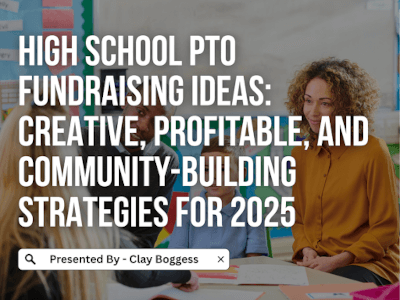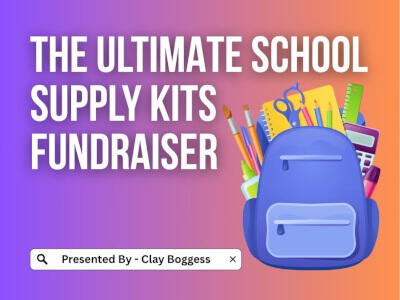
Develop a straightforward fundraiser strategy that works.
Reaching your high school fundraiser goal results from good preparation, rolling out your plan to your students, and constant seller follow-up and accountability. To succeed, you'll need to establish a strong foundation at your kickoff meeting and then maintain the sales momentum you create.
But let's be honest. You're busy and don't have a lot of extra time. You want to raise money without having to put in a lot of effort. Regardless, the last thing you want is a fundraiser that doesn't get you the desired results, so plan carefully.
Coming up with good high school fundraising ideas can be a challenge. This age group has its advantages and disadvantages. The advantages, your students are capable of having a much deeper understanding of the cause and what's required to reach their sales goals than their younger peers. This can translate into a more substantial commitment. They also tend to be more invested in their group's endeavors. They weren't forced to join your group; they chose to.
The disadvantages? Like you, your students are juggling a busy schedule. They face many challenges, including social pressures, dealing with potential home and family issues, and more demanding academic schedules. The Princeton Review also found that too much homework contributed to stress and a lack of balance.
Now try to add a fundraiser to their schedule, and you can see you have a daunting task ahead of you. It's not going to be easy, but it can be done.
Regardless of the hurdles you and your students face, here are three crucial high school fundraising tips to help you maximize your sales.
1. Have a Specific Fundraising Purpose
The foundation of your sale is your fundraising purpose. The more compelling it is, the easier it will be to win over your students and, for that matter, your supporters. You need to have buy-in from your students.
For example, a high school baseball coach may want to invest in a new pitching machine that throws different pitches. His goal is to make his players into better hitters. Becoming better at recognizing and squaring up on a curve ball requires that the players be exposed to it more often.
If the coach has done an excellent job of convincing his players that the pitching machine will provide them with the repetition they need, they'll see the value in getting the pitching machine. They'll be incredibly motivated if it helps them improve their batting average.
Yet some groups have trouble defining their purpose. Many of our high school sponsors will reply that they're raising money for the "general fund" when we ask them what they're raising money for. This may be practical, but it's not compelling. Rather your purpose should be better defined.
See Best High School Fundraising Suggestions for 2020
2. Define your Fundraising Goals
Once your students buy into your purpose, they must understand what it will take to achieve it. This is their roadmap.
Don't just hand out your fundraising materials at your kickoff meeting and tell your students to "sell as much as they can". Your students need to know what you expect them to do to be successful. Let them know precisely how many sales they'll need to make. But only after they're sold on your purpose.
Our baseball coach has determined that a new pitching machine that throws multiple types of pitches will cost $2,500. If he has 25 players in his program, each player must raise $100.
He's decided to sell school tumblers that retail for $25 each. Since the team is making a $10 profit on each tumbler, each player will need to sell 10.
Establish your fundraising goal.
3. Good High School Fundraising Ideas Track Progress
You must tell them upfront that you'll be tracking their progress. Your students know how much selling is required, but do they know you will track their progress? You should therefore plan to have three follow-up meetings.
The typical brochure fundraiser is two weeks long. If ten items are your goal, How much do you expect your students to sell by the first day? A good number to aim for is three items. Ask your students to bring their order forms and money collection envelopes for you to check. This will help ensure that everyone has gotten off to the right start.
Remember that they may not have the money collected for all three sales, but you can expect them to have the money collected for at least the first or second sale. Often they'll need to go back and collect money from a few people before the end of the sale. It's a good idea to continuously reinforce the collection of money with the order.
Where do you expect them to be at the halfway point? At this point, your sellers should be at least halfway towards their 10-item goal. A mid-sale goal of seven items will ensure they're closer to the end goal. In reality, most selling occurs within the first 3-4 days. Some may have even reached the goal. Encourage everyone to keep selling no matter how many items they've sold.
Each time you meet with your students, you remind them of the next meeting's goal. So, everyone already knows that ten items will be expected on the last check-in day. This is when all money and order forms will be turned in.
Before your end date, you'll want to remind your students about your deadline for turning in order forms and money. Everyone should be expected to reach the goal at least.
In addition to tracking sales progress, many sponsors use their check-in days to turn in money collected so far. We also recommend incorporating additional incentives that are designed to bring in even more sales.
Unfortunately, there's no easy road to high school fundraising success. But if you're looking for a sure thing, these three sales tips can go a long way toward helping you get there.
Author Bio
Clay Boggess has been designing fundraising programs for schools and various nonprofit organizations throughout the US since 1999. He’s helped administrators, teachers, and outside support entities such as PTAs and PTOs raise millions of dollars. Clay is an owner and partner at Big Fundraising Ideas.



